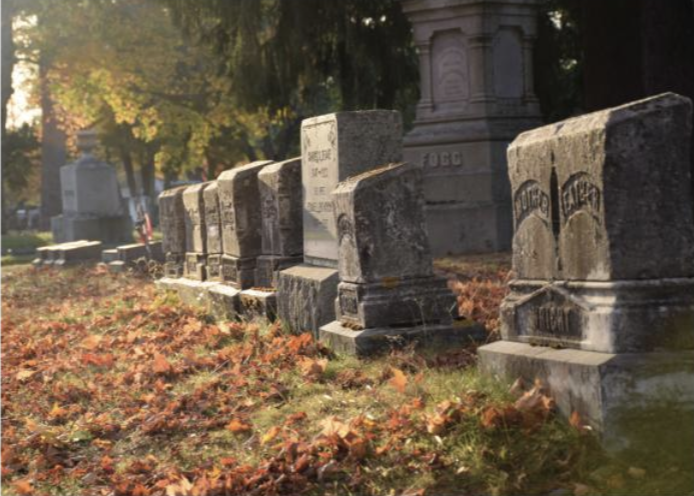By: Ben Theriault, Staff Writer
Whether it be through festive food, favorite horror movies, or costumes, many people are embracing the Autumn spirit and preparing for Halloween. Amongst all of the sweets and parties it can be easy to ignore the origins of Halloween and what exactly is being commemorated through the festivities. Many of the traditions associated with Halloween actually stem from the ancient Gaelic holiday Samhain.
The holiday spans from the sunset of October 31 to the sunset of November 1. A few thousand years ago Samhain emerged in ancient Ireland as a way to celebrate the changing seasons, honor ancestors and reconnect with the spirit world.

Halloween is an amalgam of All Saint’s Day and Samhain. There are many intersections in tradition. For example: trick or treating is an activity both participate in and, similar to jack-o-lanterns, participants of Samhain would carve faces into turnips.
Today, Samhain is celebrated by a diverse array of people such as those that identify as: Witches, Wiccans, Druids and neo-Pagans (neo-Paganism refers to the contemporary Earth-based religion rather than the traditional definition of Paganism which simply means “any religion not associated with Christianity”) amongst many others. The holiday is essential to neo-Paganism and other nature oriented religions that may conscribe to the wheel of the year.
The wheel of the year is an 8 part cycle used to measure changing seasons and cosmic events. The cycle consists of 4 lunar holidays and 4 solar holidays; Samhain is a solar holiday, commemorating the approximate halfway point between the summer equinox and the winter solstice. According to some interpretations of the wheel, Samhain marks the start of the spiritual new year.
Although there may not be much public awareness of Samhain, there are many students on campus celebrating. Gwen Walsh, a practicing Witch, noted that Samhain is one of the most important holidays to her and that it bears tremendous significance to the faith, Wicca. She described the way she celebrates the holiday “[you should] spend time alone and in your personal Void; to do that I’ll go for walks in the woods or in cemeteries for introspection. . . I’ll also do divination like Tarot reading, rune reading and scrying.”
Along with these personal ceremonies, she mentioned that she prepares an altar for the entire month of October. Another student, Katherine Muriel, described the way she creates her Samhain altar: “In terms of honoring my Latinx ancestors, I can’t help but make an obnoxiously big pot of arroz con pollo to offer a little of and to enjoy myself.” For Muriel, the holiday is a way to reflect on herself, her ancestors and her connection to nature.
Maddie Dominguez (Often referred to by the name Mudd), is celebrating Samhain for the first time this year, using a combination of candies, crystal grids, herbs and a bit of her grandmother’s ashes to honor her memory. Dominguez stated that for her, Samhain is about honoring and admiring the transition of the “life season into the death season.”
Much like Muriel, Dominguez’s background is an important part of the development of her faith. She mentioned that being of Passamaquoddy descent and growing up on a reservation has influenced the way she reflects on nature and her spirituality; she incorporates many traditional native beliefs into her interpretation of neo-Paganism.
When asked to comment on the neo-Pagan and Wiccan presence in Southern Maine, Walsh, Muriel and Dominguez all said that finding a stable community with these religions is hard because there is almost no centralization of beliefs. Despite the lack of unity, they all agreed that Paganism and Samhain are about introspection and celebrating one’s own unique identity in a way that one sees best fit.
In original Irish mythology, it is believed that during Samhain the boundary between the mortal and spirit world is at its weakest—a belief adapted and held by many variants of neo-Paganism today. By dressing as a demon one would be able to be blend in with potentially evil or unwanted spirits, thus the tradition of costumes originated as a defense against the supernatural.
Participants would also build large bonfires, which were believed to have protective and cleansing qualities. Due to these traits, many participants would cover their faces in the ashes of the fire. Rituals would be performed at these fires for a number of reasons spanning from appeasement of the gods to self-reflection in regards to the past year.
Whether religious or not, Samhain should be appreciated for its rich history and relationship with nature. Muriel commented on misconceptions of Paganism and Samhain saying that it’s nothing that needs to be inherently spooky—”it’s the natural life cycle of everything.”
If interested in being active in the neo-Pagan community, Portland hosts Pagan Pride Day annually August 9 and 10 and there are some organized events for the holiday Beltane, the solar holiday which acknowledges the midway point between the spring equinox and the summer solstice on May 1. This Samhain take some time to meditate on nature oriented philosophy. When asked about how the community could grow, Dominguez said, “many people already hold Pagan beliefs, they just don’t know how to label themselves.”

